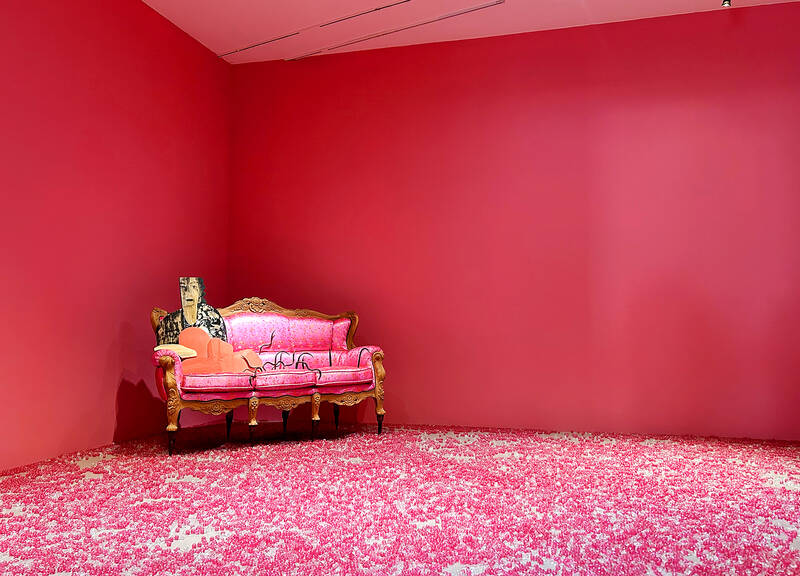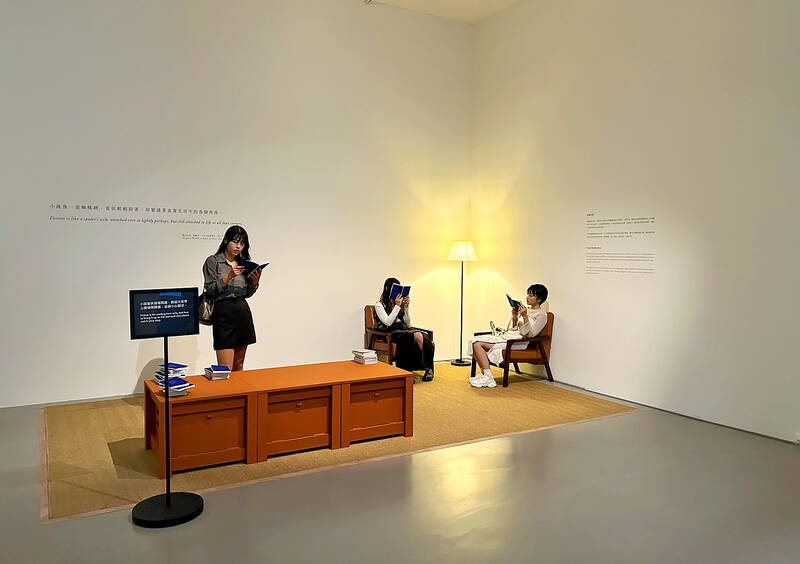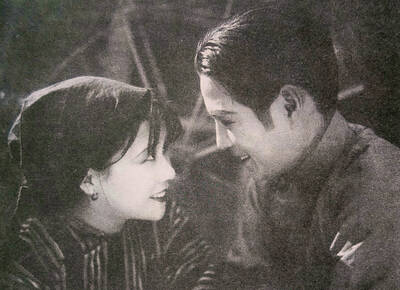The room glows vibrant pink, the floor flooded with hundreds of tiny pink marbles. As I approach the two chairs and a plush baroque sofa of matching fuchsia, what at first appears to be a scene of domestic bliss reveals itself to be anything but as gnarled metal nails and sharp spikes protrude from the cushions. An eerie cutout of a woman recoils into the armrest.
This mixed-media installation captures generations of female anguish in Yun Suknam’s native South Korea, reflecting her observations and lived experience of the subjugated and serviceable housewife. The marbles are the mother’s sweat and tears, while the chairs are a symbol of the passivity of woman in the home.
It’s a poignant introduction to Enclave: An Autobiography (飛地:一部自傳的誕生), the latest exhibition at the Taipei Fine Arts Museum. Each exhibit explores the many facets of the female experience, an audiovisual journey into women’s inner lives, darkest thoughts and wildest dreams. Running until Dec. 15, it showcases 28 female artists in a 112-piece collection spanning seven decades and comprised of paintings, sketches, videos and a commissioned biographical novel of their lives.

Photo: Hollie Younger
From a 1969 artistic interpretation of the book Little Women to the modern-day Taiwanese millennial questioning the construct of marriage, the works employ a myriad of themes, including labor division, gender equality and self-identity.
“The Enclave reveals how female artists have carved out space for creativity amid multiple identities and responsibilities,” says curator Kat Siao (蕭琳蓁).
The exhibit unfolds in three sections. Window — Quotidian Realities explores the boundary between the home and the outside world, best exemplified by Yun’s complex and unsettling installation.

Photo: Hollie Younger
Time Passes — Awareness in Changes narrates women’s self-reflections throughout life’s joys and vicissitudes. For example, Chen Hui-chiao’s (陳慧嶠) Between Stops (似停非停, 1997) features hundreds of white feathers that are tightly compressed into a glass case to symbolize her feelings of confinement and limitation.
The Lighthouse — Symbol and Pursuit turns outward, exploring politics, the environment, social structures and collective trauma. As the most dynamic and interactive segment, it invites viewers to immerse themselves in visual storytelling. Crashing waves are projected onto a wall in one part of the room, while in another visitors sit on bean bags with headphones beneath a staircase, watching a short film cast up onto the slanted wall.
This section features Huang Hai-hsin’s (黃海欣) Marriage Crisis (婚姻危機, 2012), which depicts a bride and groom, their wedding cake ablaze while guests choke on the fumes at the couple’s feet. The oil painting explores marriage as both a societal expectation and personal choice, reflecting the dilemmas faced by young Taiwanese women.

Photo: Hollie Younger
Huang says seeing her work brings up “the intense frustration and self-doubt I felt over a decade ago. Yet, amidst the turmoil, I also see a strength and resilience that I didn’t fully appreciate at the time.”
‘THE TREASURE BOX’

Photo: Hollie Younger
Siao commissioned artist Kuo Yu-ping (郭俞平) to write a short novel, The Treasure Box (珍藏盒), the only new work contained within the exhibition. Visitors can read the novella on seating chairs and cushions within an otherwise unused staircase suspended above the main exhibition floor, which it has dubbed The Study Project.
“While preparing the exhibition, we were deeply moved by the artists’ life experiences. We aimed not only to showcase their work but to convey this sense of connection,” she says.
Mirroring the exhibition experience, Kuo says that, in writing the novel, she had to travel back in time, to Taiwan under Japanese colonial rule and the post-war period, from Paris in the wake of World War II to rural Switzerland.

Photo: Hollie Younger
The novella drills to the core of this exhibition’s message: “how, within the limitations of their particular eras, did these women pursued dreams of self-fulfillment,” Kuo says.
Reading the program — and, for Chinese readers, the novel — brings more clarity and understanding to the otherwise unexplained or, in my opinion, under-explained works. Many are more abstract or surrealist, with their inspiration or stories easily passed by. Then again, perhaps that is the point, as it is perfectly emblematic of a woman’s inner world — complex, misunderstood and too often overlooked.
“It’s a testament to the enduring nature of human expression and the timeless quality of great art,” Huang says.

Photo: Hollie Younger

March 10 to March 16 Although it failed to become popular, March of the Black Cats (烏貓進行曲) was the first Taiwanese record to have “pop song” printed on the label. Released in March 1929 under Eagle Records, a subsidiary of the Japanese-owned Columbia Records, the Hoklo (commonly known as Taiwanese) lyrics followed the traditional seven characters per verse of Taiwanese opera, but the instrumentation was Western, performed by Eagle’s in-house orchestra. The singer was entertainer Chiu-chan (秋蟾). In fact, a cover of a Xiamen folk song by Chiu-chan released around the same time, Plum Widow Missing Her Husband (雪梅思君), enjoyed more

Last week Elbridge Colby, US President Donald Trump’s nominee for under secretary of defense for policy, a key advisory position, said in his Senate confirmation hearing that Taiwan defense spending should be 10 percent of GDP “at least something in that ballpark, really focused on their defense.” He added: “So we need to properly incentivize them.” Much commentary focused on the 10 percent figure, and rightly so. Colby is not wrong in one respect — Taiwan does need to spend more. But the steady escalation in the proportion of GDP from 3 percent to 5 percent to 10 percent that advocates

A series of dramatic news items dropped last month that shed light on Chinese Communist Party (CCP) attitudes towards three candidates for last year’s presidential election: Taiwan People’s Party (TPP) founder Ko Wen-je (柯文哲), Terry Gou (郭台銘), founder of Hon Hai Precision Industry Co (鴻海精密), also known as Foxconn Technology Group (富士康科技集團), and New Taipei City Mayor Hou You-yi (侯友宜) of the Chinese Nationalist Party (KMT). It also revealed deep blue support for Ko and Gou from inside the KMT, how they interacted with the CCP and alleged election interference involving NT$100 million (US$3.05 million) or more raised by the

More than 100,000 people were killed in a single night 80 years ago yesterday in the US firebombing of Tokyo, the Japanese capital. The attack, made with conventional bombs, destroyed downtown Tokyo and filled the streets with heaps of charred bodies. The damage was comparable to the atomic bombings a few months later in August 1945, but unlike those attacks, the Japanese government has not provided aid to victims and the events of that day have largely been ignored or forgotten. Elderly survivors are making a last-ditch effort to tell their stories and push for financial assistance and recognition. Some are speaking